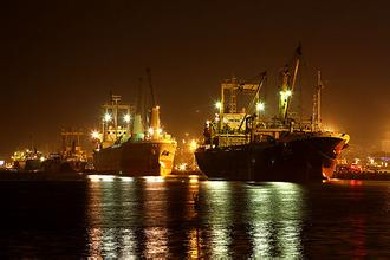Tankers are ships that carry liquid cargo, normally oil. Some are built for petroleum oil, while some are for vegetable oils and chemicals like caustic soda. When used to carry oil, the freeboard (the portion above the water level) of the ship is usually less than other ships. This is because the oil cargo is lighter than water and can contribute to the buoyancy of the ship if the ship's hull is damaged. For the control of oil pollution, the oil tanks are sometimes filled by double containment. This means there is a distance between the outside hull of the ship and the oil tank. Should the hull be damaged, there is another tank barrier which can prevent the oil from flowing out and polluting the environment.
The deck on these ships will be full of pipelines, because tankers carry their own cargo pumps. Unloading of the cargo is by pumping from the ship to shore.
Those working on crude oil vessels, have to be vigilant not to cause any electrical or friction spark while on the deck or in any explosive zones. This means no chipping of paints on deck using steel hammers. All the devices installed in these areas are explosion proof or intrinsically safe.
The atmosphere in the crude oil tanks itself is inerted with carbon dioxide gas. During loading and unloading of the cargo oil, it is especially important to maintain the inert nature of the tanks. The carbon dioxide is usually taken from the exhaust gas of the boilers. The percentage of the oxygen content in the exhaust gas has to be maintained low before it can be sent to the cargo oil tanks.
The cargo loading and unloading is usually very fast. The stay in port is thus very short. In addition, engineers usually have to maintain the operation of the cargo oil pump turbine and their associated systems. Boilers are run to supply steam to the pump turbines. Usually they will work on watches just like when the ship is underway.
During cargo pumping operations, it is very important to keep the cargo flowing in the pipes especially with freezing temperatures of the winter months. Although the cargo oil or caustic soda is heated while it is in the tank, the liquid can freeze up if the flow is interrupted. It is very difficult to make the cargo flow again if it freezes in the pipes.








